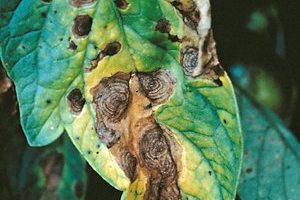Early Blight on Tomatoes

The company that makes Probiotics 4 Plants Defensor Bacterial Inoculator told me they have temporarily taken their products off the market while they create a new marketing strategy for the general public. I suggest you use Serenade(r) Garden Disease Control instead. Serenade(r) is widely available in nurseries and it is fully organic. This is biological spray. Use it exactly according to instructions. It is more of a preventative than a cure.

The best defense is planting tomatoes in clean soil where tomatoes were never grown before. Also, keep the plants clean. Clip off all brown foliage before spraying with Serenade(r). With plants growing in the ground or raised beds, make sure you are watering deeply and infrequently instead of lightly and often. This encourages deep roots. Drip irrigation is not the best way to water tomatoes. When growing tomatoes in containers, however, it is necessary to water more frequently so they do not dry out. Regarding fertilizers, feed with an organic product especially recommended for tomatoes. For good health and disease resistance, tomatoes need nitrogen, phosphorus, and potassium as well as trace minerals, especially magnesium.
Wet rainy weather early in the season has made disease problems proliferate more rapidly this year on tomatoes, particularly the heirloom types. For fewer disease problems, try growing modern hybrids which have been bred with resistance to diseases. Also from now on in future years don’t prune your tomato plants and begin spraying with Serenade earlier in the season as a preventative.


I live in Point Loma and have been fighting mildew this season like never before.I treat all of my David Austin roses and my vegetable garden organically. Any secret to getting rid of the mildew on my zucchini leaves. I just keep chopping off the affected leaves.
Serenade® gets rid of mildew and is organic. It does a good job cleaning up mildew when applied at intervals of one week. Follow package directions. Another solution is to spray the leaves with an anti-transpirant, such as Moisturin 5. Though made of a polymer, Moisturin 5 is harmless to people or plants and creates a protective coat to shield plants from pests and diseases.
Next year plant mildew-resistant varieties of squash from seeds. Nursery transplants are usually not disease-resistant hybrids, and squash is easy to grow from seeds.
Disease-resistant roses fight off mildew. The best ones need no spraying even in coastal zones. Many people want to grow ‘Double Delight’ for example. It has a heavenly fragrance, but it always succumbs to mildew along the coast and sometimes even inland. Check the qualities and characteristics of David Austins when growing those, and plant the most disease-resistant ones. It goes without saying that roses and vegetables need full sun but sometimes people try to grow them with fewer hours of sunshine than that. This always leads to problems.
I recently made a short video on the subject of mildew and it will soon be posted on my blog.
Dear Pat,
I have a question about my 5 year old Methley plum tree. I live in coastal San Pedro, CA 90732. This tree grows rapidly and I prune heavily every winter while I also use dormant spray on all my fruit trees. Why would it NOT bloom and give me lots of delicious plums?
The tree came from Armstrong and I use their E.B.Stone products.
Thanks, Andrea
‘Methley’ is a Japanese variety of plum and needs heavy pruning which you are doing correctly. It is also a low-chill variety and therefore should bear flowers and fruit in San Pedro, which is Zone 24. Last winter was unseasonably warm, however, and also subject to wide swings of temperatures from hot to cold. This could be the problem. Plums also need heavier fertilizing than other stone fruits. EB Stone products are not high in nitrogen. That may be part of the problem. So try fertilizing more. Use twice the amount you used last year. (If one box last year, two boxes this year.) Spread it under the drip line and under the branches but not within 3 feet of the trunk, and apply it one month prior to usual bloom time. Then mulch over it and water in. The reason for early feeding? Because organic products take longer to work. Another way to go is to spread horse manure as a mulch under the tree after the leaves have fallen off and the tree is dormant, maybe this year about now (early December.) Then and let the rains water it in. This provides
both mulch and fertilizer.
Perhaps next spring with more rain and I hope cooler winter temperatures this winter you tree might bear fruit. If it does not, then I recommend whipping the trunk with a blunt object like a garden hose. (For scientific reasons this actually works! If you cannot find the Q/A on that, write again and I’ll explain and tell you the story that goes with it.)
But swearing at it probably doesn’t hurt either.
Dear Pat,
Thanks so much for your response. I will fertilize more diligently ( there are horse stables nearby, I’ll ask). Is adding alfalfa meal as an extra nitrogen source a good idea? I only recently discovered your wonderful gardening book and I have learned so much! What a great recource for us gardening in SoCal and other southern locations. The Methley plum and other fruit trees surrounding are not on level ground, so I have to give it some thought on how to fertilize better to actually reach the tree’s roots.
Right now the plum still has most of its leaves, the pluot (Flavor Grenade) nearby went into dormancy very recently.
Tell me more about whipping the tree trunk! My Italian neighbor has mentioned something like that. So far, I’ve only threatened to cut it down. Again thanks for helping.
Andrea